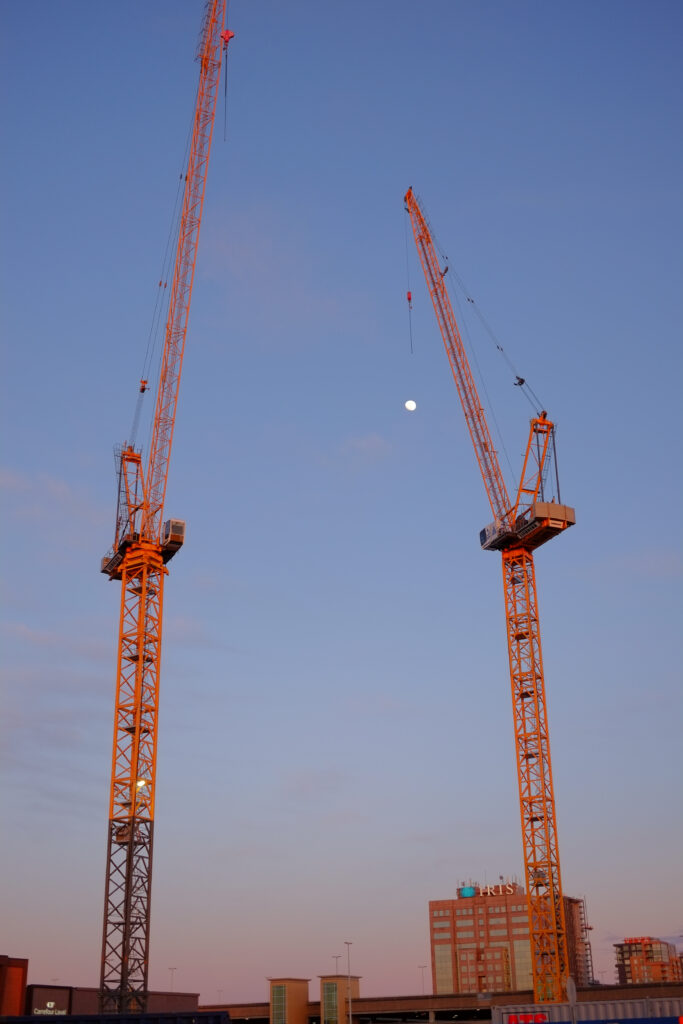
Fujifilm XT-3, Canon FD 100mm f/4 Macro — 4th April 2025
Personal ramblings on photography

DPReview has an interview of Fujifilm executives about the GFX 100RF.
Part of the reasoning is that the GFX100RF is a much more expensive camera than the X100VI, which means it needs to feel more premium. “At the beginning, when we discussed how we should design the camera, we already knew about the price point. So this camera should be more luxurious to match the price point,” said Oishi.
There is one way to avoid the supply problems: make it unaffordable. This sounds tongue in cheek, but the X100VI is still unobtainium, so is the X-M5…, the latter being one of the least expensive models.
A major factor in its luxury design is the top plate, which is milled out of a single block of aluminum—it’s the first time Fujifilm has used this type of manufacturing process.
Later, during the Fujikina event, Yoneda told us that turning an aluminum ingot into a GFX100RF top plate takes around five hours.
For so much I love well built devices, made out of metal, this looks like overkill to make it cost CA$7,000. This doesn’t make it a bad camera, but the law of diminishing returns clearly applies here.
To me, the unique feature of this camera, that also applies with the other GFX 100, is the possibility to shoot in 65:24 (or any other) aspect ratio and still have a large amount of pixels. And the GFX 100RF offers it in a smaller package. Fujifilm could offer the crops in the viewfinder for X-series and I’m sure it would work for many people with about half of the 40 Megapixels that the X100VI do offer.

SooC JPEG, Fujifilm X-Pro1, XF 27mm f/2.8 WR
April 2025
As Kosmo Photo reports that the main designer left Pentax, people are questioning the Pentax 17 future, or more realistically future Pentax film cameras.
Ricoh Imaging has said the Pentax Film Project – which led to the release of the Pentax 17 last summer – is now on hold while it investigates whether there is demand for further new film models.
If the main person behind the Pentax 17, driving the effort of film camera design, left Pentax, is there a possible future for further film cameras?
In the run-up to its release, Ricoh Imaging had said that it was investigating a raft of camera releases that could include a film SLR in due course.
I’m still not convinced that the Pentax 17 is for me. I would love to give it a try, but if I don’t enjoy shooting it, what’s the point? What I feel I might not like with the Pentax 17 is both the scale focusing and the lack of control on the exposure in general. On the other hand what I do like as a differentiator is the half frame vertical aspect ratio (but not its marketing). I do understand the constraints in the design and Pentax commitment, and this is why I hoped that they would develop further film cameras.
My ideal film camera design might be a difficult one in the current market. If it’s a reflex, a choice of mount might need to prevail to have an interchangeable lens camera. If not a reflex, it probably would have to be a fixed lens and have to be a rangefinder; otherwise a coupled rangefinder might mean Leica M mount, which mean relatively expensive glass. It’s one thing to build a camera, it’s another to build a lens system, or rely on out of production lenses. Right now film photography is on borrowed time.
Previously: Pentax 17, Reflex, a new 35mm film camera design
“V-Series”: I just made up that name. On March 26, for their video-first cameras line, Canon announced the global availability of the PowerShot V1, hoping that they sorted their manufacturing capacity. They also announced the Canon EOS R50V, a reworked version of the entry level APS-C sensor EOS R50, stripped of the viewfinder, and with improvements to the video mode. It comes (optionally) with a kit lens 14-30mm f/4-6.3 PZ. Body only, its cost is barely less than the R50, and with the kit lens it is still cheaper than the PowerShot V1:
The Canadian prices are:
This is supposed to compete with Sony ZV line of cameras. The Sony ZV-1 II is CA$1,199.00, while the ZV-E10 II without lens a 16-50 is CA$1,499 and would compete with the V1 and R50V respectively.
This is more than the PowerShot G7X MarkIII (CA$1,069.00), or even the Fujifilm X-M5 (CA$1,199.00 with the 15-45mm).
Jonas Rask tells Impossibly Possible – The Fujifilm GFX100RF review.
This very comprehensive review of the GFX 100RF as Rask had it for a few month before it was even announced. Rask really like panoramic cameras like the X-Pan or the Fuji G617, which make this camera possibly a natural fit for him.
The long rumored medium format fixed lens camera from Fujifilm was just announced.
It is called the GFX 100RF. RF stands for Rangefinder style, Fixed lens.
This camera will naturally compare with the Leica Q3 that is in a similar market segment.
The GFX 100RF has a 102 Megapixel sensor, larger than full frame (43.8mm x 32.9mm) like the one on the GFX 100II, and a newly developed fixed 35mm f/4 that is a 28mm equivalent FoV with a leaf shutter, and built-in ND filter. The lens can focus as close as 20cm front the front. The electronic viewfinder has a x0.84 magnification and 5.76 Megapixels, and it is complemented by a 3.15 in 2.1 Megapixel tilting LCD.
It has a dial that allows selecting 9 differwent aspect-ratios that, in addition to the usual ones, feature crops like 17:6 and 65:24 which are the Fujifilm G617 and T-X1 panoramic cameras respectively. There is also a vertical 3:4, that would allow taking a cropped picture in the portrait orientation. The aspect ratio dial will change the viewfinder to offer proper framing guides but the raw file will contain it all.
The digital teleconverter is a digital zoom similar to the one found on the Leica Q3 that will crop to any of 43mm, 63mm or 80mm field of view (in 35mm equivalent these are about 36mm, 50mm and 63mm respectively). The crop is done at the cost of less pixels, but since you start at 102 Megapixels, there is plenty of room to work with. Like with the aspect ratio crop, if you shoot raw, the whole image is still captured but it will be marked as cropped by default in your photo processing software (if it supports it).
There is no image stabilisation whether it is lens or in body. High speed flash sync is possible with the leaf shutter, up to 1/500 sec. There is also a dual SD-card slots and the camera is weather sealed if you install the included protective filter PRF-49.
And of course, all the usual film simulations are available.
Video
It wouldn’t be a Fujifilm without video. It doesn’t offer everything but you can shoot 4K in 30 fps, in 10 bits 4:2:2 and F-log2 with a digital images stabiliser, and there are both a headphone and a microphone jack.
Availability
The GFX 100RF is to the GFX-series what the X100 is to the X-series, albeit the latter showed up first.
MSRP is €5,499 / US$4,899 / CA$6,999, less than the Leica Q3 and available in April 2025.
Afterword
Please Fujifilm, bring these crops to the X-series. No need for a dial. Just allow assigning to a button. I want the frames in the EVF of my X-T3.
To the surprise of no one, DPReview tells us Hard to get: Canon delays orders of new V1 compact amid high demand:
Canon Announced its PowerShot V1 compact just a few weeks ago, with pre-orders only recently opening for those in Asia. Despite that, DCWatch reported that Canon has already warned that demand is high and delivery may be delayed as a result, potentially delaying its availability to the rest of the world.
Also
The PowerShot G7 X III, despite being six years old, has such high demand that Canon is suspending orders indefinitely to catch up.
And rumors are that Fujifilm is suspending order for the X-M5 as well as they can’t keep up with the demand.
I might have to get a Sony to replace my non-longer-working G7 X II I use for video.
TTArtisan is known to produce more budget friendly lenses for a variety of camera, including Fujifilm XF mount and Leica M rangefinder.
Now they are entering the market of the Instax cameras. Since the announcement is blocked by the Instagram wall, I’ll link to Kosmophoto: TTArtisan announces Folding Instant Camera which shoots Instax film:
Lens maker TTArtisan has launched a new folding camera which shoots Instax film.
It’s shooting Instax mini, it seems to be based on the Chinese Seagull 203 folding camera, and the shutter is mechanical.
Price is not available at the time.
Well…
The PowerShot G7X Mk3 has been unobtainium for a while (over a year) as my G7X MkII has been malfunctioning/breaking down, and I couldn’t replace it unless I got a Sony.
There was rumors, and they are true. Canon unveiled the PowerShot V1. This video-first camera is their answer to the Sony ZV-1, the “vlogging” camera. One big caveat: you can only get it in major Asian markets, in April 2025.
A few bits: the sensor is roughly the size of a m4/3 sensor, but in 3:2 aspect ratio, which is larger than on the G7X, it has IS, audio jack for input and output, articulated screen, 4K, and a 16-50mm equivalent.
From the picture it looks more bulky, with a bigger grip than the G7X.
To be determined is the price, and the availability in Canada (and the rest of the world).
For reference the G7X MkIII has a MSRP of CA$1,069.00, and the MarkII was about CA$100 less, the Fujfilm X-M5 with the kit lens is CA$1,199.00, and the Sony Z-V1 II is CA$999.00
To be continued.
Update: The price would be ¥148,500 which is about CA$1,400 (incl. 10% VAT)